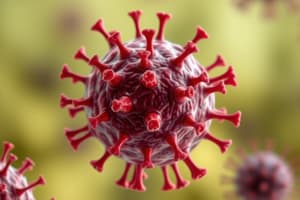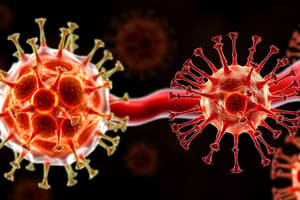Podcast
Questions and Answers
Which of the following statements accurately describes the relationship between PAMPs and DAMPs?
Which of the following statements accurately describes the relationship between PAMPs and DAMPs?
- PAMPs and DAMPs both activate the same set of pattern recognition receptors on immune cells.
- PAMPs are recognized by the innate immune system, while DAMPs are recognized by the adaptive immune system.
- PAMPs are derived from microbes and signal infection, while DAMPs are derived from damaged host cells and signal tissue injury. (correct)
- Both PAMPs and DAMPs are exclusively produced by pathogens.
Which of the following is NOT a characteristic of a pathogen-associated molecular pattern (PAMP)?
Which of the following is NOT a characteristic of a pathogen-associated molecular pattern (PAMP)?
- PAMPs can distinguish between self and non-self.
- PAMPs are encoded by genes that undergo somatic recombination. (correct)
- PAMPs are often essential for the survival of the microbe.
- PAMPs are recognized by pattern recognition receptors on immune cells.
Which of the following statements about alarmins is TRUE?
Which of the following statements about alarmins is TRUE?
- Alarmins activate the adaptive immune system, not the innate immune system.
- Alarmins are a subset of DAMPs that are released from healthy cells during damage. (correct)
- Alarmins are a subset of PAMPs that are specifically released by dying cells.
- Alarmins are exclusively produced by pathogens.
Which of the following is NOT a common example of a PAMP?
Which of the following is NOT a common example of a PAMP?
How are pattern recognition receptors (PRRs) involved in innate immunity?
How are pattern recognition receptors (PRRs) involved in innate immunity?
Which of the following statements about NOD-like receptors (NLRs) is FALSE?
Which of the following statements about NOD-like receptors (NLRs) is FALSE?
Which of the following is NOT a cell type known to express NOD-like receptors (NLRs)?
Which of the following is NOT a cell type known to express NOD-like receptors (NLRs)?
Which of the following functions is NOT associated with NOD-like receptors (NLRs)?
Which of the following functions is NOT associated with NOD-like receptors (NLRs)?
What is the primary location of NOD-like receptors (NLRs) within the cell?
What is the primary location of NOD-like receptors (NLRs) within the cell?
Which of the following is NOT a characteristic of NOD-like receptors (NLRs)?
Which of the following is NOT a characteristic of NOD-like receptors (NLRs)?
Which of the following best describes the role of NLRs in innate immunity?
Which of the following best describes the role of NLRs in innate immunity?
What is the main function of inflammasomes, which are induced by NOD-like receptors (NLRs)?
What is the main function of inflammasomes, which are induced by NOD-like receptors (NLRs)?
Which of the following statements accurately describes the relationship between NOD-like receptors (NLRs) and Toll-like receptors (TLRs)?
Which of the following statements accurately describes the relationship between NOD-like receptors (NLRs) and Toll-like receptors (TLRs)?
What is the primary function of the TIR domain within TLRs?
What is the primary function of the TIR domain within TLRs?
Which of the following is NOT a direct consequence of TLR dimerization?
Which of the following is NOT a direct consequence of TLR dimerization?
How do TLRs contribute to the enhancement of the respiratory burst?
How do TLRs contribute to the enhancement of the respiratory burst?
What is the primary function of the NOD domain in an NLR protein?
What is the primary function of the NOD domain in an NLR protein?
Which of these processes does NOT directly contribute to the degradation of engulfed pathogens within phagosomes?
Which of these processes does NOT directly contribute to the degradation of engulfed pathogens within phagosomes?
Which of the following is NOT directly involved in the activation of caspase-1?
Which of the following is NOT directly involved in the activation of caspase-1?
What is the primary role of type I interferons (IFNα and IFNβ) in innate immunity?
What is the primary role of type I interferons (IFNα and IFNβ) in innate immunity?
What is the role of the inflammasome complex in the activation of caspase-1?
What is the role of the inflammasome complex in the activation of caspase-1?
How does the activation of caspase-1 lead to the production of active IL-1β and IL-18?
How does the activation of caspase-1 lead to the production of active IL-1β and IL-18?
Which of these transcription factors is primarily responsible for the production of type I interferons?
Which of these transcription factors is primarily responsible for the production of type I interferons?
What is the main function of gasdermin D in the inflammasome pathway?
What is the main function of gasdermin D in the inflammasome pathway?
Which of the following is NOT activated by the TLR signaling pathway?
Which of the following is NOT activated by the TLR signaling pathway?
How does IL-1β influence the activity of antigen-presenting cells (APCs)?
How does IL-1β influence the activity of antigen-presenting cells (APCs)?
What is the primary role of the intracellular TIR domain in TLR signaling?
What is the primary role of the intracellular TIR domain in TLR signaling?
Which of the following statements accurately describes the autocrine signaling property of IL-1β?
Which of the following statements accurately describes the autocrine signaling property of IL-1β?
Which of the following is a consequence of TLR activation but NOT a direct consequence of ligand binding to the TLR?
Which of the following is a consequence of TLR activation but NOT a direct consequence of ligand binding to the TLR?
What is the main function of the LRR domain in NLR proteins?
What is the main function of the LRR domain in NLR proteins?
What is the primary function of β-defensins in the context of the immune response?
What is the primary function of β-defensins in the context of the immune response?
Which of the following is NOT a typical consequence of inflammasome activation?
Which of the following is NOT a typical consequence of inflammasome activation?
What is the key difference between pro-IL-1β and IL-1β?
What is the key difference between pro-IL-1β and IL-1β?
Flashcards
TLRs
TLRs
Toll-like receptors that recognize PAMPs and DAMPs.
PAMPs
PAMPs
Pathogen-Associated Molecular Patterns recognized by TLRs.
DAMPs
DAMPs
Damage-Associated Molecular Patterns signaling tissue damage.
Mucous Layer
Mucous Layer
Signup and view all the flashcards
Intestinal Epithelial Cells
Intestinal Epithelial Cells
Signup and view all the flashcards
Regulatory T Cells (Tregs)
Regulatory T Cells (Tregs)
Signup and view all the flashcards
Anti-inflammatory Cytokines
Anti-inflammatory Cytokines
Signup and view all the flashcards
NOD-like Receptors (NLRs)
NOD-like Receptors (NLRs)
Signup and view all the flashcards
NLR Proteins
NLR Proteins
Signup and view all the flashcards
C-terminal LRR
C-terminal LRR
Signup and view all the flashcards
NOD Domain
NOD Domain
Signup and view all the flashcards
Inflammasome Complex
Inflammasome Complex
Signup and view all the flashcards
CARD Domain
CARD Domain
Signup and view all the flashcards
Pro-caspase-1
Pro-caspase-1
Signup and view all the flashcards
Caspase-1
Caspase-1
Signup and view all the flashcards
IL-1β
IL-1β
Signup and view all the flashcards
IL-18
IL-18
Signup and view all the flashcards
Autocrine Signaling
Autocrine Signaling
Signup and view all the flashcards
Pathogen-Associated Molecular Patterns (PAMPs)
Pathogen-Associated Molecular Patterns (PAMPs)
Signup and view all the flashcards
Damage-Associated Molecular Patterns (DAMPs)
Damage-Associated Molecular Patterns (DAMPs)
Signup and view all the flashcards
Pattern Recognition Receptors (PRRs)
Pattern Recognition Receptors (PRRs)
Signup and view all the flashcards
Toll-like Receptors (TLRs)
Toll-like Receptors (TLRs)
Signup and view all the flashcards
Alarmins
Alarmins
Signup and view all the flashcards
Leucine rich extracellular domain (LRR)
Leucine rich extracellular domain (LRR)
Signup and view all the flashcards
TIR domain
TIR domain
Signup and view all the flashcards
Dimerization
Dimerization
Signup and view all the flashcards
Adaptor proteins
Adaptor proteins
Signup and view all the flashcards
NFκB
NFκB
Signup and view all the flashcards
Type I interferons
Type I interferons
Signup and view all the flashcards
Respiratory burst
Respiratory burst
Signup and view all the flashcards
Phagosome-lysosome fusion
Phagosome-lysosome fusion
Signup and view all the flashcards
β-Defensins
β-Defensins
Signup and view all the flashcards
Study Notes
Innate and Adaptive Immunity
- Innate immunity recognizes broad classes of microbes using pathogen-associated molecular patterns (PAMPs).
- Adaptive immunity is more specific, recognizing detailed microbial structures (antigens).
- Innate immunity uses about 1000 different molecular patterns (estimated) to recognize different microbes.
- Adaptive immunity is able to recognize over 10 antigens.
- Innate immunity is germline encoded, with limited receptor diversity.
- Adaptive immunity is encoded by gene segments through somatic recombination, leading to greater diversity.
- Innate immunity can discriminate self from non-self through recognition of host cells' lack of PAMPs.
- Adaptive immunity uses the process of eliminating or inactivating potentially harmful self-reactive lymphocytes to discriminate self from non-self.
Microbial Substances
- Microbial substances that stimulate innate immunity are commonly shared among different microbes.
- These patterns are termed pathogen-associated molecular patterns (PAMPs).
- PAMPs include viral nucleic acids, bacterial DNA, and LPS in gram-negative bacteria.
- The innate immune system identifies these substances as foreign.
Damage-Associated Molecular Patterns (DAMPs)
- The innate immune system can also identify endogenous molecules liberated from damaged or dying cells.
- These are called damage-associated molecular patterns (DAMPs).
- DAMPs can be a result of injuries from infections, chemical toxins, trauma, or other causes.
- DAMPs generally are not released from cells dying by apoptosis.
Pattern Recognition Receptors
- Cellular receptors for PAMPs and DAMPs are called pattern recognition receptors (PRRs).
- PRRs are found on cell surfaces, within phagocytic vesicles, and within the cytosol.
- Upon binding to PAMPs or DAMPs, PRRs initiate signal transduction pathways, triggering antimicrobial and proinflammatory functions within cells.
Toll-like Receptors (TLRs)
- Toll-like receptors (TLRs) are a critical class of PRRs, exhibiting evolutionary conservation.
- They recognize various microbial products, and molecules expressed by stressed or damaged cells.
- Humans have 10 different functional TLRs.
- TLRs include an extracellular Leucine-rich repeat (LRR) domain and an intracellular Toll/Interleukin-1 receptor (TIR) domain, initiating signaling cascades.
- TLR activation results in a series of signaling steps involving adaptor proteins and protein kinases, leading to the activation of various transcription factors (e.g., NF-κB, AP-1, IRF3, IRF7).
- These factors stimulate the production of genes crucial for inflammatory responses, including cytokines, chemokines, and endothelial adhesion molecules; and type I interferons for viral defense.
- TLR signaling initiates antimicrobial mechanisms like the respiratory burst, phagosome-lysosome fusion, and phagosome acidification.
- TLRs promote the production of β-defensins for direct microbial killing and immune response modulation.
Nod-like Receptors
- In addition to TLRs, NOD-like receptors (NLRs) are cytosolic sensors of PAMPs and DAMPs.
- They activate signal transduction pathways, promoting inflammation or type I IFN responses (antiviral).
- NLRs assemble into inflammasomes to activate caspase-1.
- Caspase-1 cleaves inactive precursors to form active pro-inflammatory cytokines IL-1β and IL-18.
- These cytokines promote inflammation and tissue remodeling.
Cytokines in Acute Inflammation
- Cytokines like IL-1, TNF-α, IL-6, IL-8, and IL-12 coordinate the initial response to infection or tissue damage.
- They can induce fever, increase vascular permeability, recruit immune cells, enhance antigen presentation, and promote various immune responses.
Inflammatory Response
- Inflammatory response involves changes to blood vessels to allow fluids and cells to reach the site of infection or injury.
- Leukocytes (WBCs) are crucial and arrive via a multi-step process:
- Thetering and rolling, slowing leukocyte movement to adhere to endothelium..
- Firm adhesion, involving activation and binding of integrins.
- Transmigration, involving squeezing through the endothelium.
- Chemotaxis, guiding the leukocytes towards the injury site.
Studying That Suits You
Use AI to generate personalized quizzes and flashcards to suit your learning preferences.




